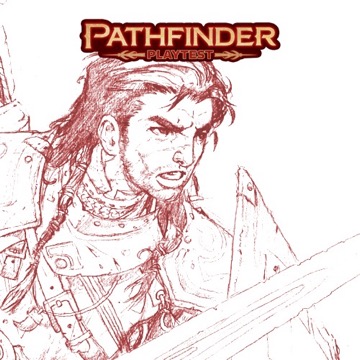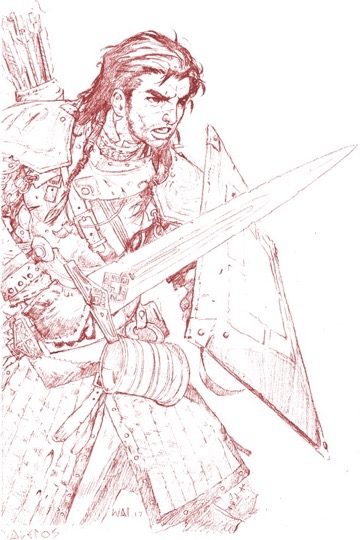Over the past 2 weeks, we've tried to give you a sense of what Pathfinder Second Edition is all about, but now it's time to delve into some details on the classes. From now until the game releases in August, we'll go through the classes one by one, pausing now and then to look at various rules and systems. Today, let's take a look at one of the most foundational classes in the game: the fighter.
The fighter was one of the first classes we redesigned, alongside the rogue, cleric, and wizard. We knew that we wanted these four to work well in concert with each other, with the fighter taking on the role of primary combat character, good at taking damage and even better at dealing damage. The fighter has to be the best with weapons, using his class options to give him an edge with his weapons of choice. The fighter also has to be mobile, able to get into the fray quickly and hold the line, allowing less melee-oriented characters time to get into position and use their abilities without have to fend off constant attacks.
Let's start by looking at some of the features shared by all fighters.
First up is attacks of opportunity. This feature allows you to spend your reaction to strike a creature within your reach that tries to manipulate an object (like drinking a potion), make a ranged attack, or move away from you. This attack is made with a –2 penalty, but it doesn't take the multiple attack penalty from other strikes you attempt on your turn. Other classes can get this ability—and numerous monsters will as well—but only the fighter starts with it a core feature. Fighters also have feat choices that can make their attacks of opportunity more effective.
Next up, at 3rd level, you gain weapon mastery, which increases your proficiency rank with one group of weapons to master. Your proficiency rank increases to legendary at 13th level, making you truly the best with the weapons of your choice. At 19th level, you become a legend with all simple and martial weapons!
The fighter gets a number of other buffs and increases as well, but one I want to call out in particular is battlefield surveyor, which increases your Perception proficiency rank to master (you start as an expert), and gives you an additional +1 bonus when you roll Perception for initiative, helping you be first into the fight!
As mentioned in the blog last week, the real meat behind the classes is in their feats and (as of this post), the fighter has the largest selection of feats out of all the classes in the game! Let's take a look at some.
You've probably already heard about Sudden Charge. You can pick up this feat at 1st level. When you spend two actions on it, this feat allows you to move up to twice your speed and deliver a single strike. There's no need to move in a straight line and no AC penalty—you just move and attack! This feat lets the fighter jump right into the thick of things and make an immediate impact.
Next let's take a look at Power Attack. This feat allows you to spend two actions to make a single strike that deals an extra die of damage. Instead of trading accuracy for damage (as it used to work), you now trade out an action you could have used for a far less accurate attack to get more power on a roll that is more likely to hit.
As you go up in level, some of the feats really allow you to mix things up. Take the 4th-level feat Quick Reversal, for example. If you are being flanked and you miss with your second or third attack against one of the flankers, this feat lets you redirect the attack to the other target and reroll it, possibly turning a miss into a hit!
We've talked before about how fun and tactical shields are in the game. To recap, you take an action to raise your shield and get its Armor Class and touch Armor Class bonuses, and then you can block incoming damage with a reaction while the shield is raised. At 6th level, fighters can take the feat Shield Warden, which allows them to use their shield to block the damage taken by an adjacent ally. At 8th, they can even get an extra reaction each turn, just to use shield block one additional time. (And yes, they can spend this extra reaction on another use of Shield Warden.) At 14th level, a fighter can use their shield to protect themself from dragon's breath and fireballs, gaining their shield's bonus to Reflex saves.
The fighter also has a wide variety of options with ranged weapons, allowing you to deal more damage up close or fire more than one arrow at a time. I foresee a lot of fighters taking Debilitating Shot, which causes a foe to be slowed if the attack hits (causing it to lose one action on its next turn).
And all this is a small sample. We've made a conscious effort to give fighters a number of paths they can pursue using their feats: focusing on shields, swinging a two-handed weapon, fighting with two weapons, making ranged attacks, and fighting defensively. These paths are pretty open, allowing you to mix and match with ease to create a fighter that matches your play style.
The goal here is to give you a variety of tools to deal with the situations and encounters you are bound to face. You might walk into a fight with your bow and open with Double Shot, allowing you to fire a pair of arrows into the two nearest foes, only to swap over to using a greataxe when the rest surround you, making an attack against all enemies in your reach with Whirlwind Strike! It all comes down to the type of fighter you want to play.
Jason Bulmahn
Director of Game Design











